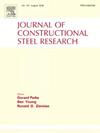采用简化模间节点模型的钢组合房屋抗倒塌研究
IF 4
2区 工程技术
Q1 CONSTRUCTION & BUILDING TECHNOLOGY
引用次数: 0
摘要
本文通过简化的构件间节点模型,对钢组合房屋的抗倒塌性能进行了评价。分析了单层、三层和六层中小住宅楼的角柱和边柱拆除方案。研究了包括螺栓布置和直径在内的节理结构对中小型连轴器节理性能和整体抗破坏能力的影响。提出了一种连接节点盖板的加固策略,并对其对结构抗倒塌性能的贡献进行了评价。结果表明,减小螺栓数量和螺栓直径会显著降低接头的抗拉、抗剪和抗弯能力。然而,SMB整体结构抗倒塌能力的下降幅度相对较小,在5%到13%之间。通过连接盖板,水平节点的极限抗拉承载力和极限抗剪承载力分别提高了约67%和35.4%。此外,在角柱损失和边柱损失下,SMB的结构最大承载能力分别提高了2.1% ~ 4.7%和5.1% ~ 12%。通过连接盖板,螺栓最少(腹板2个,法兰1个)的SMB的最大结构承载能力可以提高到与螺栓最多(腹板6个,法兰2个)的SMB的最大结构承载能力基本匹配。研究强调了层间效应对多层SMB承载能力的关键作用。此外,在边柱损失的作用下,模组梁中的悬链线作用对SMB的抗倒塌也起着至关重要的作用。这些发现为中小型企业的设计和优化提供了有价值的见解,以增强其对进行性崩溃的稳健性。本文章由计算机程序翻译,如有差异,请以英文原文为准。
Collapse resistance of steel modular buildings using a simplified inter-module joint model
This study evaluates the collapse resistance of steel modular buildings (SMBs) through a simplified inter-module joint model. Corner and edge column removal scenarios are analyzed for the single-storey, three-storey, and six-storey SMBs. The study investigates how joint configurations, including bolt arrangement and diameter, affect joint performance and overall collapse resistance of SMBs. A strengthening strategy, involving the connection of cover plates of the joint, is proposed, and its contribution to the structural resistance against collapse SMB is evaluated. The results show that decreasing the number and diameter of bolts reduces the tensile, shear and bending capacities of the joint by measurable margins. However, the reduce in overall structural anti-collapse capacity of the SMB remains relatively modest, ranging from 5 % to 13 %. By connecting the cover plates, the ultimate tensile capacity and ultimate shear capacity of the horizontal joint are enhanced by approximately 67 % and 35.4 %, respectively. Moreover, the structural maximum load capacity of the SMB is improved by 2.1 %–4.7 % in corner column loss and 5.1 %–12 % in edge column loss. By connecting the cover plates, the maximum structural load capacity of the SMB with the fewest bolts (two in the web and one in the flange) can be increased to nearly match that of the SMB with the most bolts (six in the web and two in the flange). The study stresses the vierendeel effect's key role in the multi-storey SMB's load-carrying capacity. Additionally, catenary action in module beam also plays a vital role in resisting collapse of the SMB under edge column loss. These findings provide valuable insights into the design and optimization of SMBs to enhance their robustness against progressive collapse.
求助全文
通过发布文献求助,成功后即可免费获取论文全文。
去求助
来源期刊

Journal of Constructional Steel Research
工程技术-工程:土木
CiteScore
7.90
自引率
19.50%
发文量
550
审稿时长
46 days
期刊介绍:
The Journal of Constructional Steel Research provides an international forum for the presentation and discussion of the latest developments in structural steel research and their applications. It is aimed not only at researchers but also at those likely to be most affected by research results, i.e. designers and fabricators. Original papers of a high standard dealing with all aspects of steel research including theoretical and experimental research on elements, assemblages, connection and material properties are considered for publication.
 求助内容:
求助内容: 应助结果提醒方式:
应助结果提醒方式:


